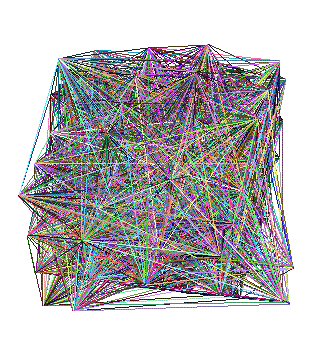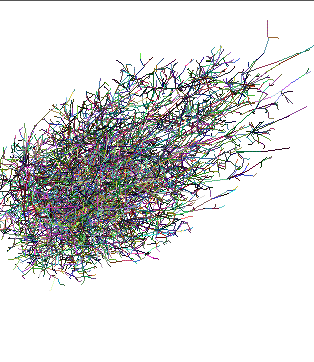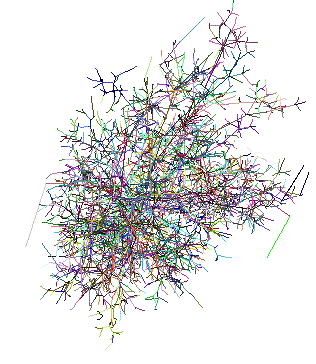LinkExchange Member
Updated Mon Oct 16 10:20:25 PDT 1995
Here are some results from my Internet Mapping project. I am endeavouring to
make maps of the Internet for various purposes. These include:
- calculation
of latency pools
- backbone and domain analysis
- strategic server
placement
- general navigation and visualization
The process happens in several phases.
traceroute to cluon.com (205.164.127.1), 30 hops max, 40 byte packets 1 nexus-3.catapent.com (206.26.116.65) 2 ms 2 ms 5 ms 2 border2-serial4-6.Denver.mci.net (204.70.29.69) 29 ms 29 ms 28 ms 3 core-fddi-1.Denver.mci.net (204.70.3.113) 29 ms 29 ms 40 ms 4 core-hssi-3.SanFrancisco.mci.net (204.70.1.38) 52 ms 52 ms 54 ms 5 borderx2-fddi0-0.SanFrancisco.mci.net (204.70.3.164) 53 ms 54 ms 53 ms 6 fix-west-nap.SanFrancisco.mci.net (204.70.158.118) 56 ms 54 ms 55 ms 7 mae-west.net99.net (198.32.136.16) 277 ms 77 ms 96 ms 8 3-E0.SanJose.net99.net (204.137.135.187) 65 ms 62 ms 68 ms 9 204.157.1.158 (204.157.1.158) 65 ms 66 ms 65 ms 10 r2.brainstorm.net (205.164.112.34) 66 ms 64 ms 64 ms 11 gateway.cluon.com (205.164.127.2) 89 ms 177 ms 94 ms 12 cluon.com (205.164.127.1) 115 ms 214 ms 91 ms
A graph coloring algorithm with back-propogation is used to find these latency pools.

- Latency Attraction. a node is attracted to its directly connected neighbors. It attempts to position itself so that its distance from each connected neighbor is a linear function of its latency to that neighbor.
- Spatial Repulsion. a node exerts a repulsion field on all nodes that are within a pre-defined distance from it. This repulsion field is dampened for neighboring nodes which are topologically connected to the node.
Iteration of this algorithm tends to unfold the Net map, while creating regions which are topologically connected. The length of links in the map is propotional to the latency between those links.


These maps were generated between Oct 12, 1995 and Oct 16, 1995. The routes that make up the above maps took over 80 hours to collect, and set off at least one Internet security advisory warning! Several more weeks and we'll be done our first pass!
180 iterations of the placement algorithm on this data took 7.5 hours on a Sun Sparcstation5. It required about 7Mb of space (tiny!).